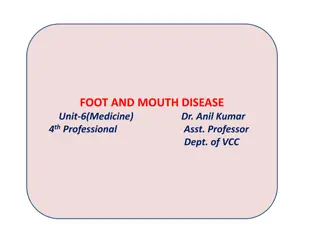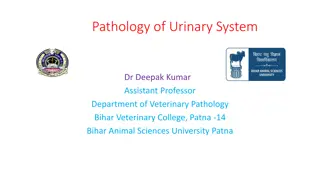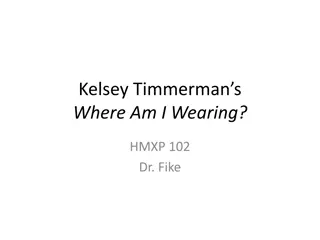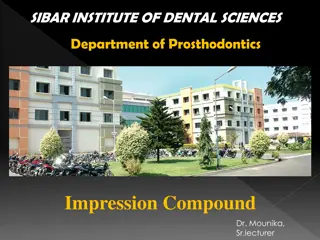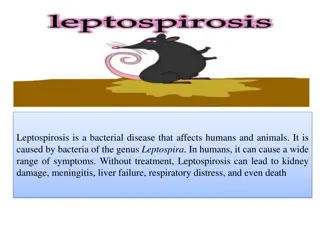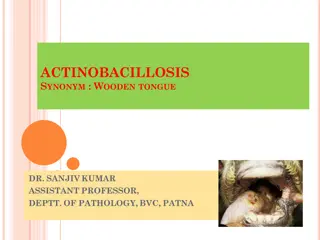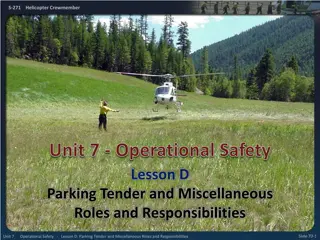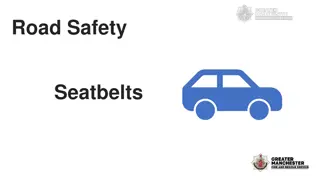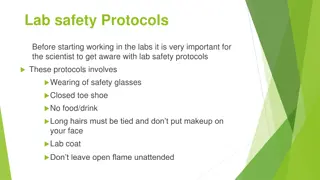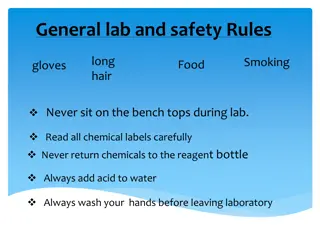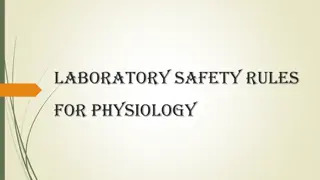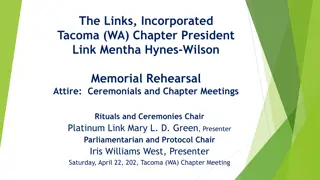Understanding the Sequelae Caused by Wearing Complete Dentures
Denture use can lead to various sequelae, including denture stomatitis, angular cheilitis, flabby ridge, traumatic ulcers, and more. These issues can cause discomfort, destabilization of occlusion, loss of retention, decreased masticatory function, poor aesthetics, and increased ridge resorption. Factors contributing to these sequelae include inadequate maintenance, material properties, operator errors, allergic reactions, and microporosities. Understanding these effects is crucial to prevent prosthetically maladaptive conditions.
Download Presentation

Please find below an Image/Link to download the presentation.
The content on the website is provided AS IS for your information and personal use only. It may not be sold, licensed, or shared on other websites without obtaining consent from the author. Download presentation by click this link. If you encounter any issues during the download, it is possible that the publisher has removed the file from their server.
E N D
Presentation Transcript
SEQUELAE CAUSED BY WEARING SEQUELAE CAUSED BY WEARING COMPLETE DENTURES COMPLETE DENTURES
CONTENTS INTRODUCTION ETIOLOGY TYPES OF SEQUELAE DENTURE STOMATITIS ANGULAR CHELITIS FLABBY RIDGE TRAUMATIC ULCERS OR SORE SPOTS DENTURE IRRITATION HYPERPLASIA
BURNING MOUTH SYNDROME GAGGING RESIDUAL RIDGE REDUCTION OVER DENTURE ABUTMENTS: CARIES AND PERIODONTAL DISEASE ATROPHY OF MASTICATORY MUSCLES NUTRITIONAL DEFICIENCIES GENERAL PRECAUTIONS TO PREVENT SEQUELAE CONCLUSION
INTRODUCTION What is Sequelae ? An after effect of a disease, condition or injury. It is a secondary result.
INTRODUCTION Denture use is not free of trouble. It can produce severe side effects which if left untreated will produce: 1.Destabilization of occlusion 2.Loss of retention 3.Decresed masticatory function 4.Poor esthetics 5.Increased ridge resorption and tissue injury
INTRODUCTION All these disorders produced or accelerated in oral tissues due to presence of denture are grouped as SEQUELAE OF WEARING COMPLETE DENTURE . These problems progress to stage where patient is considered PROSTHETICALLY MALADAPTIVE and hence cannot wear dentures.
ETIOLOGY Inadequate maintenance by patient Properties of material Error from operator Allergic reactions Microporosities leading to plaque accumulation Continuous wear of denture Overextension Flange width inadequate Inaccurate fit Occlusal plane too high Inadequate freeway space Cuspal interference.
DENTURES CAN CAUSE? SURFACE MUCOSAL REACTIONS POOR FUNCTION IRREGULARITIES AND MICROPOROSITIES MECHANICAL IRRITATION AND PLAQUE ACCUMULATION PLAQUE FORMATION NEGATIVE EFEECT ON MUSCLE FUCTION BACTERIA USE PMMA AS CARBON SOURCE. ALLERGIC REACTIONS
TYPES OF SEQUELAE DIRECT SEQUELAE INDIRECT SEQUELAE DENTURE STOMATITIS ATROPHY OF MASTICATORY MUSCLES FLABBY RIDGE NUTRITIONAL DEFICIENCY DENTURE IRRITATION HYPERPLASIA OR EPULIS FISSURATUM ALLERGIC REACTION TRAUMATIC ULCERS BURNING MOUTH SYNDROME GAGGING OVER DENTURE ABUTMENTS:CARIES AND PERIODONTAL DISEASE
TYPES OF SEQUELAE IMMEDIATE SEQUELAE DELAYED SEQUELAE BURNING MOUTH SYNDROME DENTURE STOMATITIS GAGGING DENTURE IRRITATION HYPERPLASIA TRAUMATIC ULCERS OR SORE SPOTS FLABBY RIDGE RESIDUAL RIDGE REDUCTION OVER DENTURE ABUTMENT CARIES
DENTURE STOMATITIS The word stomatitis means inflammation of oral mucosa. Denture stomatitis is a term used to indicate an inflammatory state of denture bearing mucosa. Other names are Denture induced stomatitis, Inflammatory papillary hyperplasia and chronic atrophic candidiasis.
CLASSIFICATION LOCALIZED SIMPLE INFLAMMATION TYPE 1,2,3 GENERALIZED DIFFUSE ERYTHMATUS DENTURE STOMATITIS CANDIDA ASSOCIATED IF YEAST IS INVOLVED
DENTURE STOMATITIS STAINS OF GENUS CANDIDA ,PARTICULRLY CANDIDA ALBICANS CANDIDA ASSOCIAED CAUSES TRAUMA INDUCED , CAUSED BY MICROBIAL PLAQUE ACCUMULATION TYPES 1,2 AND 3 ANGULAR CHELITIS OR GLOSSITIS DUE TO INFECTIONFROM DENTURE COVERED MUCOSA TO ANGLES OF MOUTH OR TONGUE. CANDIDA ASSOCIATED DENTURE STOMATITIS AND ANGULAR CHELITIS
DENTURE STOMATITIS DIAGNOSIS: The diagnosis of Candida associated denture stomatitis is confirmed by finding of mycelia or pseudohyphae in a direct smear ,or by isolation of Candida species in high numbers from the lesion . Yeasts are recovered in high numbers from fitting surface of dentures than from corresponding areas of palatal mucosa which indicates that Candida residing on fitting surface of denture is primary source of infection. Candidal growth has been associated with mandibular dentures relined with soft liner. The most commonly detected yeasts were strains of the genus Candida, in paticular C. albicans, C. glabrata and C. tropicali
MANAGEMENT APPROPIATE DENTURE WEARING HABITS DENTURE SANITIZATION. MECHANICAL PLAQUE CONTROL. Denture soaked overnight in an antiseptic solution such as chlorhexidine or dilute sodium hypochlorite. Patient instructed to remove dentures after meal and scrub them vigorously before reinserting them. Mucosa in contact with denture should be kept clean and massaged with a soft tooth brush.
If fungal organism is present: TOPICAL ANTIFUNGAL THERAPY SYSTEMIC ANTIFUNGAL THERAPY Seen in Type2 diabetes mellitus patients. Clotrimazole(1%) cream Ketoconazole or fluconazole.(200- 400)mg Nystatin lozenges
ANGULAR CHELITIS Angular cheilitis. An inflammation of the corners of the mouth is sometimes seen in cases of denture stomatitis and then often correlated with a Candida albicans infection. It is thought that infection may start beneath the maxillary denture and from that area spread to corners of mouth. However this infection often results from local or systemic predisposing conditions such as over closure of jaws , general health factors such as nutritional deficiencies and immune dysfunction.
FLABBY RIDGE CLINICAL PRESENTATION M MANDIBULAR TEETH ALVEOLAR RIDGE MOBILE AND EXTREMELY RESILIENT SEEN IN ANTERIOR PART OF MAXILLA OPPOSING NATURAL HISTOPATHOLOGY MARKED FIBROSIS ,INFLAMMATION AND RESORPTION OF THE UNDERLYING BONE CAUSES UNSTABLE OCCLUSAL CONDITIONS EXCESSIVE LOAD ON RESIDUAL RIDGE
Management CONVENTIOAL PROSTHODONTICS WITHOUT SURGICAL INTERVENTION IMPLANT RETAINED PROSTHESIS SURGICAL REMOVAL Various impression techniques are LIMITATION : DECREASE IN VESTIBULAR HEIGHT Economic concerns 1. Two tray technique 2. Window impression technique REQUIRING VESTIBULOPLASTY
DENTURE IRRITATION HYPERPLASIA OR EPULIS FISSURATUM CLINICAL PRESENTATION HYPERPLASIA OF MUCOSA OCCURS ALONG BORDERS OF DENTURE SINGLE OR NUMEROUS LESIONS FLAPS OF HYPERPLASTIC CONNECTIVE TISSUE PRESENT HISTOLOGY CELLS RESEMBLE NORMAL CELLS BUT ARE GREATLY INCREASED IN NUMBER CAUSES ILLFITTING DENTURE INJURY DUE TO THIN OVEREXTENDED DENTURE FLANGE PROBLEMS AND SUGGESTED SOLUTION: :REPLACEMENT OR ADJUSTMENT OF DENTURE
TRAUMATIC ULCERS CLINICAL PRESENTATION Small painful lesions,covered by a gray necrotic membrane and surrounded by an inflammatory halo with firm ,elevated borders Develop within 1-2 days after placement of new dentures CAUSES Caused due to overextended denture flanges or unbalanced occlusion. TREATMENT In a non compromised host ulcers will heal after correction of dentures.When left untreated it subsequently develops into denture irritation hyperplasia.
BURNING MOUTH SYNDROME Characterized by a burning sensation in one or several oral structures in contact with dentures. Symptoms often appear for first time in association with placement of new dentures. Common sites are tongue and upper denture bearing tissues . Less common sites are lips and lower denture bearing tissues. Oral mucosa appears normal
3 types of BMS have been described by LAMEY and LEWIS 1989 TYPE1: There are no symptoms on waking. A Burning sensation then commences and becomes worse as the day progresses. This Pattern occurs everday.33% of patients fall into this category and are likely to include those haematinic deficiencies and defects in denture designs
Type2: Burning is present on waking and persists throughout the day. Occurs everyday. About 55% of patients are placed in this category , a high proportion of whom have anxiety and are most difficult to treat successfully . Type3: Patients have symptom free days. Burning occurs in less usual sites such as floor of mouth , throat and buccal mucosa.
Type3: Main causative factors are allergy and emotional instability. They make up for the remaining 12% of patients. CAUSES: LOCAL FACTORS: Mechanical irritation Allergy due to residual monomer Infection or oral habits Myo facial pain
Errors in denture design which cause a denture to move excessively over the mucosa which increase the functional stress on the mucosa or which interfere with the freedom of movement of the surrounding muscles may initiate a complaint of burning rather than soreness . Seen in 50% of BMS patients. Systemic Factors: Vitamin deficiency, iron deficiency anemia, xerostomia, menopause, diabetes.
MANAGEMENT: Initial assessment ( history/ examination/ special test) Provisional diagnosis Initial treatment( elimination of local irritants and investigating and treating haematinic deficiencies) Assessment of initial treatment
Definitive diagnosis Definitive treatment( local/ systemic/ pyschological therapy) Follow up
GAGGING Stimulation of sensitive area in posterior pharyngeal wall , soft palate ,uvula, fauces or posterior surface of tongue results in series of uncoordinated and spasmodic movements of swallowing muscles. This is referred to as gagging.
CAUSES Loose dentures Poor occlusion Incorrect extension or contour of dentures particularly in posterior area of palate and retromylohyoid space Under extended denture borders. Placing the maxillary teeth too far in a palatal direction and , mandibular teeth too far in lingual direction Increased vertical dimension of occlusion. Psychogenic factors
MANAGEMENT Distraction techniques Relaxation Pharmacological techniques - Local Anesthesia - Conscious Sedation Prosthodontic techniques Impression Techniques Marble Technique Palate Less Denture Altering gag reflex via palm pressure
MANAGEMENT DISTRACTION TECNIQUE: Conversation can be useful, or the patient may be instructed to concentrate on breathing, for example, inhaling through the nose and exhaling through the mouth. Distracting the patients mind by having him raise his foot Until this tiring exercise requires more conscious effort and a concomitant conversation
MANAGEMENT PHARMACOLOGICAL TECHNIQUES Local Anaesthesia: The deposition of local anesthetic around the posterior palatine foramen has been used for patients who gag when the posterior palate is touched. Conscious sedation : Nitrous oxide alters the perception of external stimuli and it is suggested that this altered perception depresses the gag reflex. Combination of hyoscine, hyoscyamine and atropine with a sedative drug can be given in initial period of denture use.
MANAGEMENT IMPRESSION TECHNIQUE: Borkin recommends low-fusing wax as an impression material for gagging patients. This material can be seated repeatedly between gagging episodes until a satisfactory impression is obtained. The low-fusing wax must be hardened in the mouth. This is done by squirting ice water from a bulb syringe along the borders of the completed impression and over as much of the impression surface as possible. Copious amounts of ice water should be used because the impression must be thoroughly chilled before it is removed. The ice water will retard the paroxisms of gagging by its cooling effect so this chilling can be done with a minimum of difficulty.
MANAGEMENT THE MARBLE TECHNIQUE: Five round multi-coloured, glass marbles, approximately 1/4inch in diameter, were placed on a tray in front of the patient. The patient was told to put the marbles in his mouth, one at a time, at his leisure, until all five marbles were in his mouth. Since the fear of swallowing a foreign object can induce the gag reflex, the patient was assured that if he swallowed a marble, it could not harm him. Continual assurance that he would be able to wear dentures was given to the patient at each weekly visit. He was urged to keep the five marbles in his mouth continuously for one week, except when eating and sleeping.
MANAGEMENT PLATE LESS DENTURES: A cast metal denture base of aluminum or chrome nickel alloy is recommended. The primary advantage is the achievement of intimate contact between the denture base and the underlying tissue, which markedly increases the retention of the prosthesis. The metal base also provides rigidity to resist breakage, uniform thickness of material, a beaded metal finish line on the palatal surface, and a stable substructure for recording jaw relations. The metal base extends from the palatal bead line to cover the crest of the ridge.
MANAGEMENT ALTERING GAG REFLEX VIA PALM PRESSURE POINT The pressure point used is located in the middle of the palm at the angle of intersection of the thumb and the third digit marking. The patients hands at his intersection is marked with a marker. With the help of hand pressure device ,pressure is applied at this point and patient is asked not to resist to the pressure while the force is increased manually of the actuator to two pounds and gag trigger point (Hegupoint) is described.
ALTERING GAG REFLEX VIA PALM AND PRESSURE POINTS.
RESIDUAL RIDGE REDUCTION Residual ridge resorption: This is the most common and important sequel of wearing complete denture which is chronic, progressive, irreversible & cumulative. Definition: RRR is a multi factorial, biomechanical disease that results from a combination of anatomic, metabolic, and mechanical determinants. The basic structural change in RRR is a reduction in the size of the bony ridge under the mucoperiosteum. It is primarily a localized loss of bone structure.
The process of resorption important in areas with thick cortical bone(e.g buccal and labial plates of maxilla and lingual plates of mandible) The annual rate of reduction in height in mandible is about 0.1-0.2 and in general 4 times less in edentulous maxilla.
ATWOOD CLASSIFICATION for categorizing most common mandibular residual ridge configurations: - Order 1 pre extraction. Order II post extraction Order III high,well rounded. Order IV knife edge Order V - low, well rounded. Order VI - depressed
ACCORDING TO FALLUSCHUSSEL Six orders of maxillary ridge resorption: 1.Fully preserved 2. Moderately wide and high 3. Narrow and high 4. Sharp and high 5. Wide and reduced in height 6. Severly atrophic
ETIOLOGICAL FACTORS Intensive denture wearing Unstable occlusal conditions. Immediate denture treatment Metabolic and systemic factors like osteoporosis Mechanical factors transmitted by dentures or tongue to residual ridges results in remodelling process
CONSEQUENCES OF RESIDUAL RIDGE RESORPTION Apparent loss of sulcus width and depth Displacement of muscle attachment closer to crest of residual ridge Loss of vertical dimension of occlusion Reduction of lower face height Anterior rotation of mandible Changes in interalveolar ridge relationship after progression of residual ridge reduction.
TREATMENT Pre prosthetic surgery includes the following: Ridge preservation procedure as a preventive measure Corrective or recon touring procedures of defects and abnormalities Ridge extension procedures: Relative methods: sulcus extension( vestibuloplasty) Absolute methods : Ridge augmentation methods
PROSTHETIC FACTORS CONSIDERED TO REDUCE RESIDUAL RIDGE RESORPTION Broad area coverage Decreased bucco lingual width of teeth Improved tooth form Avoidance of inclined planes Centralization of occlusal contacts Provision of adequate tongue room Adequate inter-occlusal distance during rest jaw relation.
OVER DENTURE ABUTMENTS:CARIES AND PERIODONTAL DISEASE Wearing of over denture is often associated with a high risk of caries and progression of periodontal disease of abutment teeth. This is due to bacterial colonization beneath a close fitting denture is enhanced and good plaque control of fitting denture surface is difficult to obtain. Predominant microorganisms are streptococcus, lactobacilli and actinomyces.
These species initiate gingivitis after 1-3 days of plaque accumulation when oral hygiene is discontinued. Presence of streptococcus mutans and lactobacillli in dental plaque flora in high proportions results in caries.
ATROPHY OF MASTICATORY MUSCLES ESSENTIAL THAT MASTICATORY FUNCTION BE MAINTAINED THROUGH OUT LIFE MASTICATORY FUNCTION DEPENDS ON THE SKELETAL MUSCULAR FORCE AND THE ABILITY TO COORDINATE ORAL FUNCTIONAL MOVEMENTS DURING MASTICATION MAXIMAL BITE FORCES DECREASE IN OLDER PATIENTS



